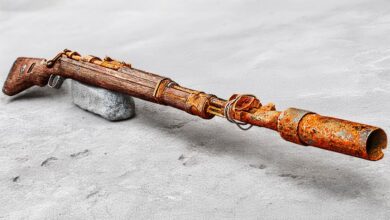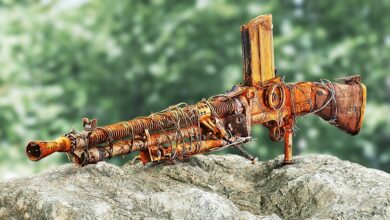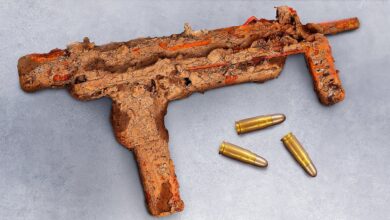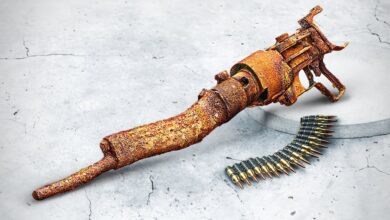1928 DP-27: A Legacy Restored – The Art of Old Machine Gun Restoration
The 1928 DP-27, often referred to simply as the DP-27, is a legendary Soviet light machine gun that became one of the most iconic weapons of its era. Originally designed in the late 1920s, it was an essential part of the Red Army during the Second World War and beyond. Known for its distinctive round pan magazine, reliable performance, and unique design, the DP-27 holds a place of respect among firearm collectors, historians, and military enthusiasts. However, like many pieces of history, it’s not immune to the ravages of time. For enthusiasts and collectors alike, the process of restoring an old DP-27 is both a challenge and an art form.
The Origins of the DP-27
The DP-27 was designed by Vasily Degtyaryov in 1927 and became one of the Soviet Union’s primary light machine guns throughout World War II. The gun’s unique characteristics, including its distinctive 47-round pan magazine, gas-operated mechanism, and reliability, made it a favored weapon on the battlefield. Its performance was solid, although it had its drawbacks, such as the relatively heavy weight and the awkwardness of carrying it over long distances. Despite its age, the DP-27 remains a notable piece of military history, often sought after by collectors due to its historical significance.
The Challenge of Restoring a Classic
Restoring a 1928 DP-27 machine gun is not a task for the faint of heart. These guns were produced in the early 20th century, and many of the original models have since seen years of wear and tear, as well as the wear that comes with being used in battle. A machine gun restoration involves a thorough understanding of the weapon’s components, as well as significant expertise in the tools and techniques required to bring it back to life.
1. Finding the Right Parts
One of the most significant challenges of restoring a DP-27 is sourcing authentic parts. Many of the original pieces, such as the unique pan magazine, are difficult to find. Some parts may also be damaged beyond repair, requiring precision fabrication or modifications from skilled craftsmen. Restorers often have to rely on original documentation, blueprints, and a deep knowledge of Soviet-era weaponry to ensure they maintain historical accuracy.
2. Inspection and Assessment
Once an original DP-27 is located, the restoration process begins with a comprehensive inspection. The condition of the receiver, barrel, bolt, and gas system are paramount in determining whether the gun can be restored to a functional or merely a display condition. The magazine is often one of the most troublesome parts due to its design, and if it’s severely worn or damaged, it may require complete replacement or reconditioning.
3. Cleaning and Refinishing
Over the years, old firearms can accumulate rust, grime, and fouling, which can compromise their functionality and appearance. Restoration typically involves careful disassembly of the weapon for cleaning, with each part being carefully scrubbed, degreased, and inspected. Rust removal is done meticulously, usually with abrasives that won’t damage the original metal. Once cleaned, parts are refinished to restore the original look, often through bluing or parkerizing, techniques used to preserve the metal while enhancing its durability.
4. Reassembly and Function Check
After all the parts have been cleaned, refinished, and replaced where necessary, the gun is reassembled. The function check is one of the most critical aspects of restoration. This involves ensuring that the gas operation system works smoothly, that the bolt cycles correctly, and that the weapon operates reliably in a way that mimics the original factory specs.
Challenges in Restoration
Restoring a DP-27 isn’t merely about replacing broken parts or cleaning old components. One of the unique challenges faced by restorers is keeping the weapon’s historical integrity intact. The DP-27 was manufactured with precise tolerances, and the slightest deviation from the original design can affect its functionality and authenticity. This means that restorers must not only be expert gunsmiths but also experts in Soviet military technology.
The age of these weapons also makes them particularly prone to wear and tear. Many parts of the DP-27 were constructed using materials that may not be as durable as modern alloys and composites. Restoring them often involves balancing modern techniques with the use of historical materials. Some restorers might use contemporary materials to replace missing or damaged parts, but this can alter the original feel and function of the gun. Striking a balance between modernization and preservation is a critical aspect of the restoration process.
The Value of Restoration
For many, the DP-27 is a living piece of history. Restoring it is more than just fixing a broken machine gun—it’s about preserving a link to a pivotal moment in global history. The restored DP-27 is a valuable collector’s item, not only due to its rarity but also because of its place in history. For museums, collectors, and reenactors, owning a functioning DP-27 can provide a tangible connection to the past.
Beyond the military and historical significance, restoring a DP-27 is also an exercise in craftsmanship. Each restoration represents a marriage of precision engineering and a deep respect for the craftsmanship of those who originally designed and built the weapon. A restored DP-27 stands as a testament to the ingenuity of its creators, as well as to the skill of the modern gunsmiths who bring it back to life.
Conclusion
Restoring a 1928 DP-27 is a challenging yet deeply rewarding process that combines history, craftsmanship, and technical skill. While these iconic Soviet machine guns are no longer in active service, their legacy remains strong, and through careful restoration, they can continue to tell the stories of the soldiers who once wielded them. For collectors and historians alike, restoring an old DP-27 is not just about making an old firearm functional again; it’s about preserving a piece of history that will forever carry the marks of a tumultuous era in global warfare.





